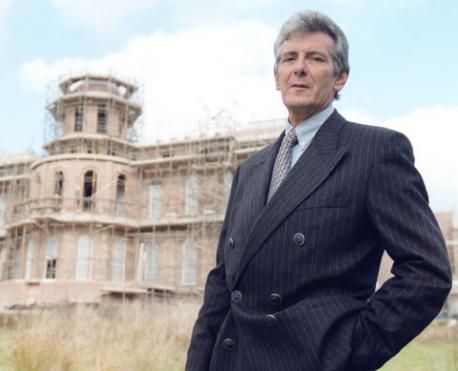


 TYCOON Nicholas van Hoogstraten (pictured) has written to the embattled Hwange Colliery Company Limited demanding an extraordinary general meeting (EGM) where he will fight to axe the board and top management before roping in a judicial manager to revive the colliery miner which declared a shock US$44 million pre-tax loss for the year to December 2013. The US$44 million loss was a 10-fold slide from a US$4 million loss suffered in 2012.
TYCOON Nicholas van Hoogstraten (pictured) has written to the embattled Hwange Colliery Company Limited demanding an extraordinary general meeting (EGM) where he will fight to axe the board and top management before roping in a judicial manager to revive the colliery miner which declared a shock US$44 million pre-tax loss for the year to December 2013. The US$44 million loss was a 10-fold slide from a US$4 million loss suffered in 2012.
Van Hoogstraten holds 30 percent shareholding in Hwange, the second largest shareholder after government, which controls a 37 percent stake. The multi-millionaire British tycoon has been outraged by the prolonged carnage at the firm that he alleges has lost US$500 million since 2009 through “corruption and fraud”. He is determined to fire those he accuses of milking the once successful bellwether counter. But this could be another futile exercise.
He would have to mobilise several minorities to fight in his corner to swing the vote in his favour when his demands come before a shareholder vote in 28 days. He has given Messina Investments, one of his investment vehicles, the mandate to deal with the blazing crisis at Hwange.
“We hereby give notice, as the major public, and long standing shareholder of Hwange that we require an EGM to be held for the purpose of a resolution(s) to place the company under judicial management and for the appointment of Mr Afaras Gwaradzimba as the judicial manager,” Messina’s letter said.
“We have been forced to take this action to protect the interests of all shareholders and workers (who have been unpaid for eight months) while no attempts have been made by management to eliminate well-established corrupt and uncommercial activities,” said Messina.
Hwange’s 2013 results exposed extreme write-downs and revealed how many years of under-capitalisation, shareholder dogfights, and mismanagement have pushed the firm to the brink. Technically insolvent and in dire need of working capital to save an operation that supports 2 800 workers and a community of 55 000, Hwange’s revenues plunged to US$72,5 million last year, from US$104 million in 2012. Coal output fell by 16 percent to 1,9 million tonnes, from 1,6 million tonnes in 2012.
Despite trimming its 3 000-strong workforce by 200, overheads marched north, pushing operating losses to a massive US$40 million, from US$7,1 million in 2012.
Hwange is in the firestorm. Its negative working capital position deteriorated to US$77,2 million last year, from a US$20,7 million black hole in 2012. It has run out of liquid cash to lubricate day to day operations, and this explains why by September 2013, Hwange owed staff US$14 million in outstanding salaries, with a combined debt of US$160 million.
It owed the Zimbabwe Revenue Authority and the National Social Security Authority a combined US$50 million. Hwange’s balance sheet was worth US$248 million in 2013. The haemorrhage has re-ignited the prolonged ire between rival shareholders who have failed to strike common ground over a proposed US$50 million bailout by van Hoogstraten. His offer has been confronted by headwinds.
The board has rejected his demands for a raft of reforms that would hand him management control, even after initially turning to him for a US$20 million lifeline. Under his tough conditions, van Hoogstraten had proposed a five-year technical services and management agreement. The effective management control was to be made through a designated Willoughby’s (one of his investment vehicles) Special Purpose Vehicle, which was to report to the board.
A coordinating committee comprising three Willoughby’s representatives and two Hwange directors was to be established, after which the loan was to be formalised and secured through issuance of a convertible loan stock at 10 percent interest and a conversion rate of one new 25 cent ordinary share for each US$0,50 of loan stock. The offer was one of the cheapest at Hwange’s disposal in recent times.
But it has been affected by extensive political muscle-flexing in Zimbabwe, where foreign investors are increasingly seen as vehicles for re-colonisation. Rafts of policies have been put in place recently that restrict the extent to which foreign investors can fund local projects. Van Hoogstraten’s offer appeared to have been affected by the unfortunate politics. He said it was sad that Hwange was trending towards insolvency when looters were walking scot-free.
“They don’t want to admit,” he said.
“The company is insolvent; how does it survive? We have people who are living well beyond their means who are supposed to be in jail.”
He told the Financial Gazette this week that his proposal to axe the board was part of a strategy to arrest carnage and backstage deals. He led a similar revolt at Rainbow Tourism Group, which resulted in a board reshuffle and top management changes in 2012.
“Enough is enough,” he told the Financial Gazette.
“How can you run down a world class coal mine? Hwange was a shining example in Africa. You look at the infrastructure there, it was the first time that sort of investment was put in place in Africa. It is losing US$1 million per week. But those massaged results show that it is losing US$600 000 per week. These people are destroying your country,” he said.
In September, van Hoogstraten tabled a US$50 million bailout package for the listed coal giant after it became clear that it would continue bleeding unless it receives fresh capital injection. Hwange requires in excess of US$85 million.
Meanwhile, in our story entitled Van Hoogstraten gives Hwange ultimatum two weeks ago, we erroneously reported that the Farai Mtamangira board had been removed.
The correct position is that Mtamangira is still the chairman of the loss-making giant.
newsdesk@fingaz.co.zw